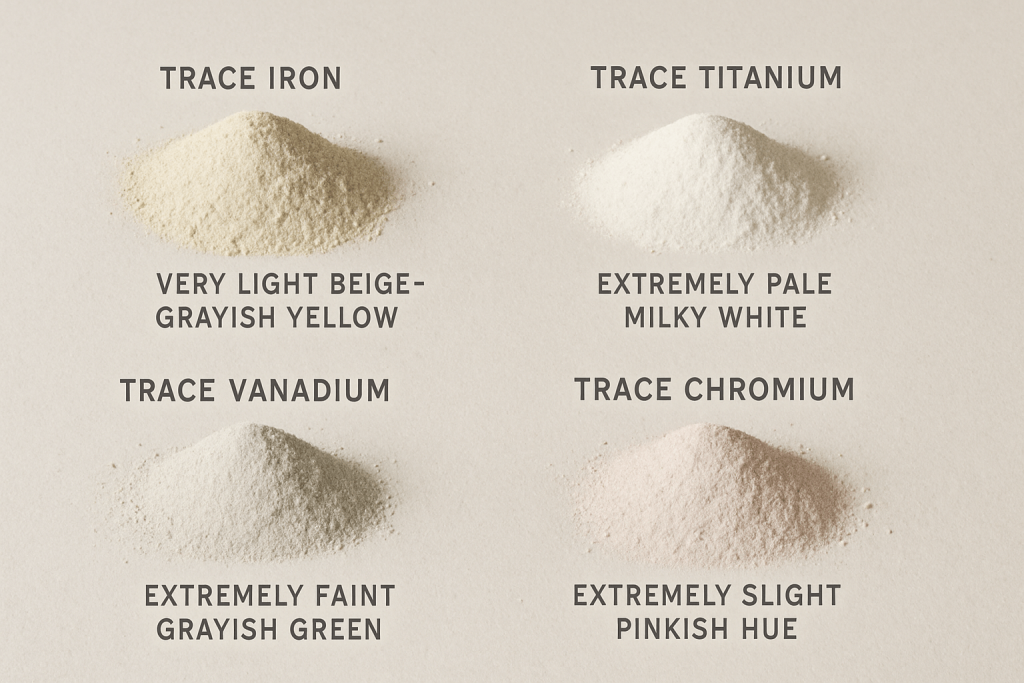Understanding the factors affecting color in zirconium silicate is essential for industry professionals responsible for ensuring product quality in their operations. Variations in color can arise from multiple sources, including the presence of impurities and differences in processing methods. When these issues occur, it can create significant complications for purchasing managers and decision-makers who rely on specific material properties to meet their stakeholders’ demands.
This article strives to provide a comprehensive exploration of why zirconium silicate color changes, focusing on impurities and processing factors that influence its appearance. Readers will gain actionable strategies for sourcing reliable zirconium silicate materials, while also maintaining quality consistency, ultimately ensuring their products fulfill established industrial standards.
Why Is Color Consistency in Zirconium Silicate Critical?
The importance of color consistency in zirconium silicate should not be underestimated. In the realm of industrial applications, maintaining uniformity in color is critical for ensuring product performance and meeting customer expectations. This compound is widely used in various sectors, including ceramics, coatings, and refractory materials, where specific color characteristics play a significant role in the final appearance and effectiveness of the products.
In the ceramics industry, for example, the color of ZrSiO₄ can directly influence the aesthetic quality of finished items, such as tiles and sanitary ware. Buyers often seek a high degree of whiteness, which not only reflects purity but also enhances the overall visual appeal of the product. When color variation occurs, it can lead to significant mismatches in color during glaze application, resulting in products that do not meet market standards. This inconsistency can undermine customer confidence, diminish brand reputation, and ultimately result in lost sales.
Furthermore, many industries rely on precise color matching for functional reasons. In coatings, for instance, consistent whiteness is essential for ensuring uniform coverage and performance characteristics of the finished surface. Variations in color can lead to uneven application, requiring adjustments that waste time and resources. Additionally, discrepancies in color can affect the perceived quality of the product, discouraging buyers from purchasing specifically labeled items.
Moreover, achieving consistent color is often tied to regulatory compliance. Many industries must adhere to strict quality control standards that include specifications for color consistency. As such, fluctuations in zirconium silicate color can create compliance challenges that may lead to product rejections or recalls, resulting in both financial loss and reputational damage.
Ultimately, color consistency in zirconium silicate is not merely a cosmetic consideration; it is an integral aspect that impacts manufacturing efficiency, product quality, and customer satisfaction. As market competition intensifies, the ability to provide reliably consistent color will determine the success of companies that depend on zirconium silicate in their formulations. Prioritizing quality control measures to eliminate color variation can thus provide a competitive edge and solidify market position.

This image features ceramic items that exhibit different glaze colors, illustrating the impact of color consistency in products.
What Role Do Impurities and Trace Elements Play?
Imparting color variation in zirconium silicate is predominantly due to the presence of impurities. Among the impurities, iron oxide (Fe₂O₃) emerges as a significant contributor to changes in coloration. Even minute trace amounts of ferric oxide can significantly alter the material’s visual characteristics, introducing unwelcome hues such as yellow, pink, or brown. The relationship between the source of raw materials and iron content is crucial, as certain mining and extraction processes may yield higher levels of iron, subsequently impacting the end product’s final appearance or quality.
To elaborate, many materials sourced from naturally occurring deposits may contain varying levels of contaminants based on how they were extracted or processed. If a supplier does not conduct thorough quality checks, this could introduce variations that affect the aesthetic quality of zirconium silicate. By being aware of these potential sources of contamination, businesses can make more informed decisions when selecting their suppliers, ultimately ensuring a more consistent product.
Let’s shift our focus to titanium (TiO₂), which, while not as prevalent as iron, can still play a pivotal role in shifting the color of zirconium silicate, particularly in ceramic glazes.. It tends to introduce a subtle cream or yellowish tone into ZrSiO₄. This is particularly pertinent when titanium occurs alongside iron, amplifying the overall color variation in the material.
Moreover, other transition metals such as vanadium and chromium can also subtly influence the compound’s coloration. These metals, even when present in small amounts, can add cumulative effects that complicate the color profile of the final zirconium silicate. Each metal interacts with the other components during both processing and implementation, leading to further challenges in color consistency.

This image highlights various impurities affecting zirconium silicate color, illustrating the complexity of maintaining consistent hues.
To illustrate the impact of these impurities on color, consider the table below which summarizes the main impurities affecting zirconium silicate coloration, along with their potential impacts.
| Impurity | Source | Color Variations |
|---|---|---|
| Iron (Fe₂O₃) | Raw materials | Yellow, Pink, Brown |
| Titanium (TiO₂) | Clays and ores | Cream, Yellow |
| Vanadium | Various sources | Grayish hues |
| Chromium | Pigments | Subtle shifts in color |
Taking the time to understand these impurities reveals how potential sources of zirconium silicate may contribute to unwanted color changes. This knowledge is critical for professionals tasked with ensuring the integrity of their products, ultimately aiding in more vigilant supplier selection and quality control procedures.
How Do Processing Techniques Affect Color Variation?
The processing techniques employed during the production of zirconium silicate are crucial determinants of its final color. Among these techniques, milling and particle size distribution (PSD) are fundamentally significant. The degree to which the material is ground impacts its surface area, which can affect how light interacts with it. Fine grinding can enhance the perception of whiteness due to improved light scattering. However, this beneficial effect is not without its risks. Contamination from grinding media—including steel or ceramic balls—can introduce undesired coloration into the material.
To cite an example, a manufacturer may choose to use a steel ball mill for grinding zirconium silicate. While this can achieve fine particle sizes necessary for certain applications, it may also lead to slight iron contamination, which can manifest as undesirable colors in the finished product. This phenomenon highlights the necessity for rigorous quality checks during not only the grinding process but also the selection of appropriate grinding materials.
Another vital aspect to consider is the calcination temperature and atmosphere utilized during processing. High-temperature processing significantly affects the oxidation state of impurities present. For instance, iron can exist in two primary states—Fe²⁺ (ferrous) and Fe³⁺ (ferric)—with each state contributing differently to the expected color outcomes in zirconium silicate. For example, Fe²⁺ tends to exhibit darker shades, while Fe³⁺ typically aligns more closely with the expected whitish appearance. Thus, a controlled firing environment is essential to mitigate unwanted color variations.
The table below illustrates the specific temperature ranges and their impact on the oxidation states of iron, offering insights into their influence on zirconium silicate color.
| Temperature Range | Iron State | Possible Color Outcome |
|---|---|---|
| Below 900°C | Fe²⁺ | Slightly darker shades |
| 900°C – 1200°C | Fe³⁺ | Expected white shades |
| Above 1200°C | Mixed state | Potential for brown hues |
By closely managing these processing parameters and being mindful of the potential outcomes, manufacturers can significantly enhance their ability to control zirconium silicate color and quality, leading to more consistent products that meet industrial expectations.

This image depicts a calcination process in a kiln for zirconium silicate to illustrate how temperature affects color variation.
How Are Measurement and Quality Control Ensured?
Measuring and ensuring color consistency in zirconium silicate is integral to maintaining the high-quality standards required in various industries. Standard industry techniques, such as the CIE Lab* color space, provide a reliable framework for quantifying color. Within this framework, focus is predominantly placed on the L* value, which indicates lightness. Assessing the L* value facilitates an understanding of the product’s whiteness level, enabling comparisons across different batches.
For companies that utilize ZrSiO₄ in their products, maintaining batch-to-batch consistency is critical to the performance and marketability of their end goods. Minor shifts in color can affect industrial applications such as ceramic glaze matching, which relies heavily on precise color replication to deliver satisfying end results. Thus, implementing rigorous quality control protocols becomes paramount.
The following table summarizes common measurement techniques utilized in assessing the quality and consistency of zirconium silicate.
| Measurement Technique | Purpose |
|---|---|
| CIE Lab* | Standard color measurement |
| L* Value | Determines lightness/whiteness |
| Spectrophotometry | Provides detailed color analysis |
Incorporating these measurement techniques into quality control processes allows businesses to achieve more accurate results, ensuring that customers consistently receive high-quality zirconium silicate. This attention to detail not only improves customer satisfaction but also reduces the risk of costly production setbacks due to color inconsistencies.
How Do Partnerships Enhance Purity and Color Consistency?
In the quest for superior quality, the significance of selecting the right partners cannot be overstated. Collaborating with reliable suppliers is essential for achieving both purity and maintaining color consistency in zirconium silicate production. A firm commitment to sourcing high-quality raw materials plays a pivotal role in this regard. Businesses stand to gain immensely by forming strategic partnerships with suppliers who prioritize the integrity of their materials. By doing so, they ensure that the raw inputs are characterized by minimal impurities, which can otherwise lead to unwanted color variations.
Furthermore, the use of advanced purification techniques also plays a vital role in ensuring high color standards in zirconium silicate products. Techniques such as acid washing and magnetic separation are essential in minimizing potential color-causing impurities. These methods act as a safeguard against contaminants entering the final product, solidifying a manufacturer’s ability to offer consistently high-quality offerings.
A solid quality assurance process is equally important. By implementing strict Lab* testing and process controls, businesses can maintain minimal batch variations, ensuring that customers enjoy high-quality products consistently. This approach builds trust and reliability in supplier relationships, securing a competitive edge.
The table below outlines key aspects of partnership strategies that enhance color purity.
| Partnership Aspect | Benefits |
|---|---|
| Sourcing High-Quality Materials | Reduces risks of impurity |
| Advanced Purification Techniques | Improves overall color consistency |
| Rigorous Quality Assurance | Guarantees minimal batch variations |
Integrating these strategies can lead to reliable and consistent products, ultimately benefiting manufacturers and their end-users. When businesses prioritize partnership and collaboration, they not only enhance their product offerings but also strengthen their position in the market.
Conclusion:What Are the Key Takeaways Regarding Color Variation?
In conclusion, color variation in zirconium silicate is a multifaceted issue rooted in impurities and processing techniques. Awareness of the roles played by iron, titanium, and other trace elements provides valuable insight into managing these factors effectively. Moreover, processing conditions such as milling and calcination temperature influence color outcomes and necessitate careful consideration.
Importantly, companies must adopt precise measurement and quality control methods to maintain consistent colors across product batches, while fostering partnerships that emphasize purity and quality sourcing.
The tangible benefits of ensuring reliable and consistent quality in zirconium silicate cannot be overlooked. Such diligence not only upholds product standards but also enhances customer satisfaction in an increasingly competitive landscape. For those looking for dependable solutions, Global Industry is here to support your needs with expert insights, unwavering commitments to quality, and a promise of collaboration towards achieving your goals in zirconium silicate.
FAQ Section
Q1: What causes color variations in zirconium silicate?
Color variations are typically a result of impurities and specific processing methods th at can significantly alter the expected coloration. Impurities—such as iron oxide and titanium dioxide—play a key role, while variations in processing conditions, like milling and calcination temperature, also contribute to different hues.
Q2: How does iron affect zirconium silicate color?
Trace amounts of iron oxide can lead to yellow, pink, or brown hues, thereby modifying the anticipated whiteness of the product. The level of iron often correlates with the source of raw materials, which means that selecting high-purity feedstock is essential for maintaining consistent color.
Q3: Why is particle size important for color consistency?
The fineness achieved during milling affects light scattering, potentially enhancing perceived whiteness but also introducing risks of contamination. A careful balance between achieving the desired particle size and minimizing contamination risk is crucial for maintaining uniform color in the final product.
Q4: How do processing conditions impact the oxidation states of impurities in zirconium silicate?
High-temperature calcination can change the oxidation states of impurities like iron, significantly affecting the final color of zirconium silicate. For instance, differences in temperature and processing atmosphere can shift iron from Fe²⁺ to Fe³⁺, leading to variations in the coloring of the final product.
Q5: What role do advanced purification techniques play in maintaining color consistency in zirconium silicate?
Advanced purification techniques, such as acid washing and magnetic separation, are critical for removing color-causing impurities that can adversely affect the final product’s appearance. These processes help ensure a more consistent and desirable color by targeting specific contaminants before the final product is processed and sold.
